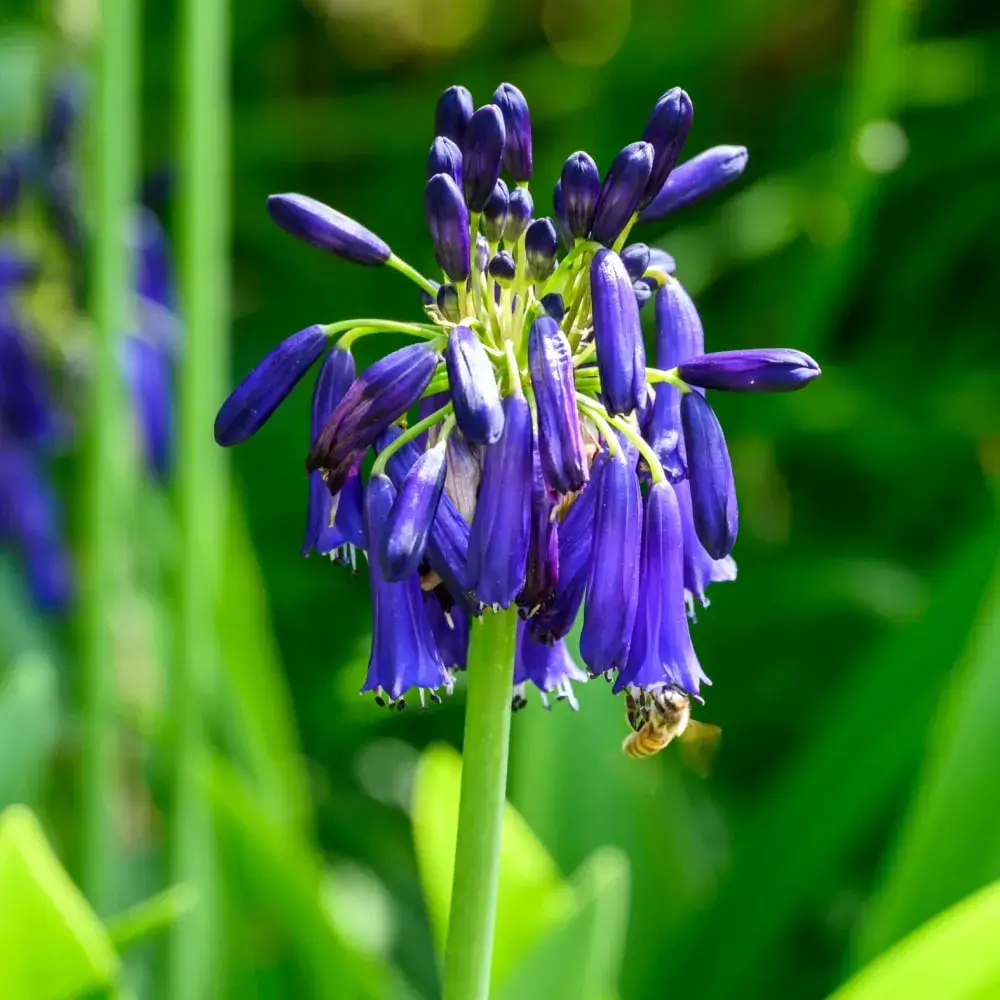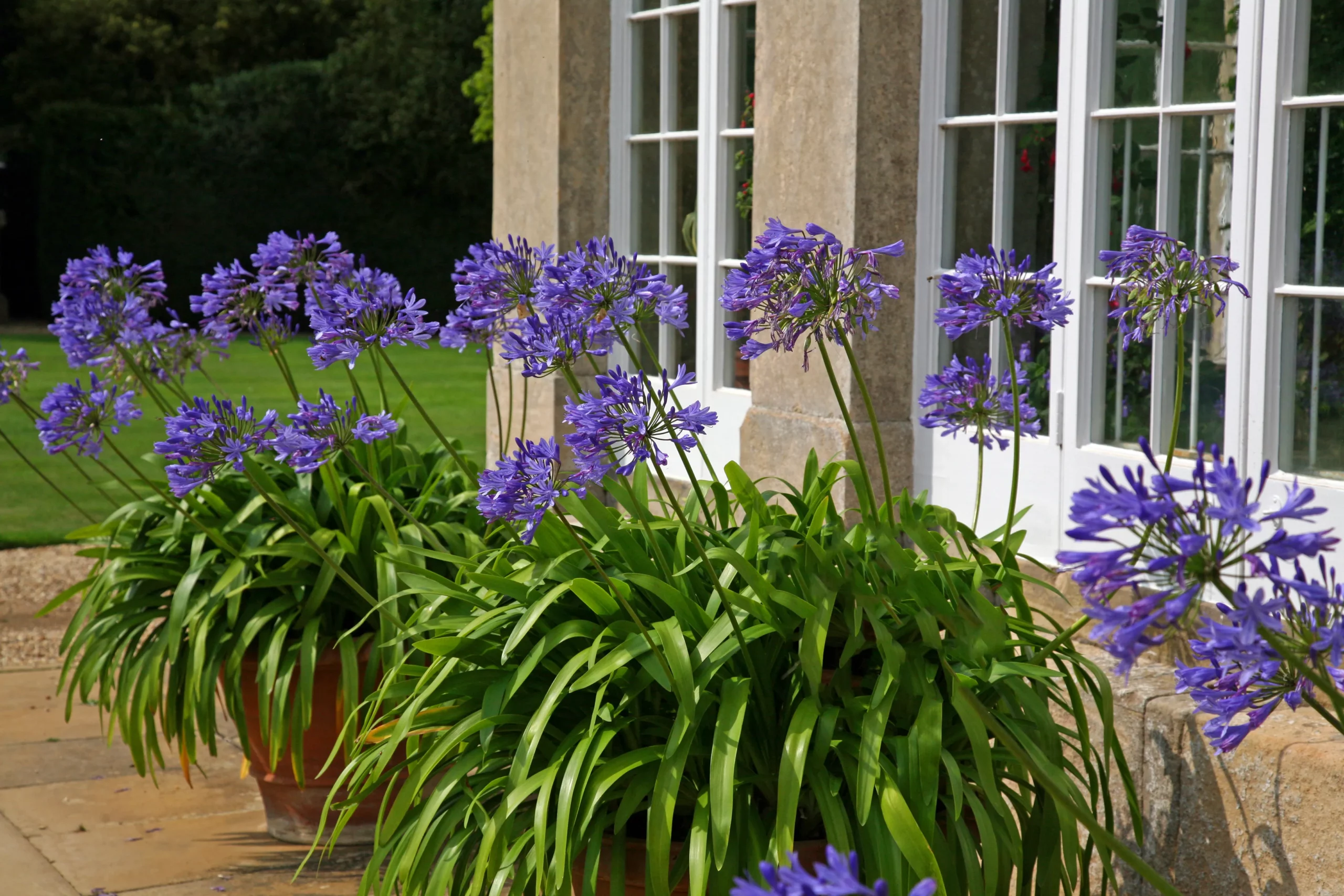Family: Agapanthus
Type: Perennial
Other Common Name: Lily of the Nile, African Lily

Graskop Agapanthus is a striking perennial, known for its large umbels of deep blue flowers. It thrives in sunny conditions and well-drained soil.
This South African native is robust and low maintenance, making it a favorite among gardeners. It blooms in summer, adding a vibrant splash of color.
Its strappy green leaves create a lush backdrop, even when not in bloom. The Graskop Agapanthus is perfect for borders and ornamental gardens.
Hardiness Zone: 7a-11a
Pet Friendly: Yes
Moisture Preference: Average to moist
Sun Needs: Full sun to partial shade
Growth Rate: Medium
Average Height (feet): 2
Average Spread (feet): 3
Average Life Span (years): 10
Form: Over mound
Flower Color: Blue
Flower Shape: Trumpet
Bloom Season: From late spring to early summer
Foliage Color: Green
Foliage Shape: Narrow
Incorporating Graskop Agapanthus in your garden brings a touch of the exotic. Its tall flower stalks are ideal for creating vertical interest.
Plant clusters of Graskop Agapanthus for a stunning, cohesive look. They pair well with both grasses and other flowering plants.
These plants are excellent for defining walkways or garden paths, creating a structured yet natural appearance.

In a cottage garden setting, Graskop Agapanthus adds a romantic flair. Its lush foliage and vibrant blooms complement the informal, densely planted style. Plant them alongside traditional cottage garden flowers like roses and lavender for a charming effect.
For a modern landscape, Graskop Agapanthus offers clean lines and bold colors. Its architectural form works well in minimalist designs. Pair with geometric planters or alongside structured pathways for a contemporary look.
In coastal gardens, the hardy nature of Graskop Agapanthus makes it an ideal choice. Its tolerance for windy conditions and sandy soil fits perfectly with the seaside aesthetic. Combine with other salt-tolerant plants for a resilient, yet beautiful coastal garden.
Plant Graskop Agapanthus in groups for a dramatic display. Their height and color make them natural focal points.
Use them to line driveways or property boundaries for a neat, organized look. Their robust nature means they can thrive in these often-overlooked spaces.
For a low-maintenance garden, Graskop Agapanthus is a perfect choice. It requires minimal care yet offers maximum impact.
Select our pre-made garden layouts to create a landscape that’s uniquely yours. Simple, smart, and customizable!
In spring, Graskop Agapanthus begins to show its lush green foliage. The leaves emerge vigorously, preparing the stage for the summer bloom. This period is perfect for enjoying the fresh, verdant growth before the floral show.
Summer is the Graskop Agapanthus' time to shine. The plant erupts in a spectacular display of deep blue flowers. These blooms stand tall above the foliage, attracting butterflies and creating a lively garden atmosphere.
During fall, Graskop Agapanthus' blooms fade, but its foliage remains vibrant. The plant begins to prepare for dormancy, yet the leaves continue to add greenery to the garden. It's a time to appreciate the plant's structural beauty.
In winter, Graskop Agapanthus enters dormancy. In colder regions, the foliage may die back, while in milder climates, it remains evergreen. This period is for rest and rejuvenation, setting the stage for the next year's growth.
Graskop Agapanthus thrives in a sunny spot with good air circulation. It’s ideal for open areas in the garden, where it can receive at least six hours of sunlight daily. Avoid planting in overly shaded areas to ensure healthy growth.
Full sun is crucial for Graskop Agapanthus. These plants need ample sunlight for optimal flowering. A location that receives direct sunlight for most of the day is perfect, especially to encourage the vibrant summer blooms.
Well-drained soil is essential for Graskop Agapanthus. They prefer loamy or sandy soil that retains moisture but doesn't stay waterlogged. Soil with good organic content will support healthier growth.
Space Graskop Agapanthus plants about 18-24 inches apart. This spacing allows for adequate air circulation and room for growth. Crowding them can lead to poor flowering and increased susceptibility to diseases.
The best time to plant Graskop Agapanthus is in the spring after the last frost. This timing allows the plants to establish roots before the hot summer months and ensures a robust bloom season.
Plant Graskop Agapanthus at the same depth they were in their nursery pot. Water them well after planting to settle the soil. Ensure the crown of the plant is not buried too deep to avoid rot.
Regular watering is important, especially during dry spells. However, avoid overwatering, as Agapanthus does not like soggy soil. Reduce watering frequency in the winter when the plant is dormant.
Feed Graskop Agapanthus in early spring with a balanced fertilizer. A second feeding may be done after the first bloom to encourage more flowers. Avoid over-fertilizing, as this can lead to lush foliage at the expense of blooms.
Deadhead spent blooms to encourage new flowers. Cut back the foliage to the ground in late fall or early winter if it dies back, to keep the plant tidy.
In spring, remove any dead foliage and apply a layer of compost or a balanced fertilizer. This is the time for the plant to build up energy for blooming, so adequate watering is necessary.
During summer, Graskop Agapanthus is in its full glory. Ensure consistent watering, especially during dry periods. Deadheading spent flowers can encourage a second bloom.
In fall, reduce watering as the plant prepares for dormancy. No fertilization is needed during this time. Begin to prepare for winter by clearing any fallen leaves around the plants.
In winter, Graskop Agapanthus requires little care. In colder areas, mulch around the base to protect roots from freezing. In milder climates, the plant may retain some foliage, which should be left undisturbed.
Graskop Agapanthus is moderately frost-tolerant. In areas with mild winters, it often survives without special care. However, in regions with harsher frosts, it’s best to mulch around the base or grow them in pots that can be moved indoors.
Divide Graskop Agapanthus every 3-4 years to maintain health and vigor. This process helps rejuvenate overcrowded clumps and encourages more blooms. The best time for division is in early spring or after the flowering season.
Yes, Graskop Agapanthus is considered toxic to both dogs and cats if ingested. The plant contains substances that can cause vomiting, diarrhea, and other gastrointestinal issues in pets. It’s advisable to plant them in areas away from pet access.
Sign up below to get exclusive deals, discounts, and new plant collections—delivered straight to your inbox! Plus, stay inspired with the latest gardening tips, landscaping trends, and DIY garden ideas. Start growing with us today!
A big thank you for subscribing to the PBN Design newsletter.
We're thrilled to have you join our community. Get ready for exciting updates, insightful content, and more delivered straight to your inbox.
Stay tuned!
Go backA big thank you for subscribing to the PBN Design newsletter.
We're thrilled to have you join our community. Get ready for exciting updates, insightful content, and more delivered straight to your inbox.
Stay tuned!
Go back